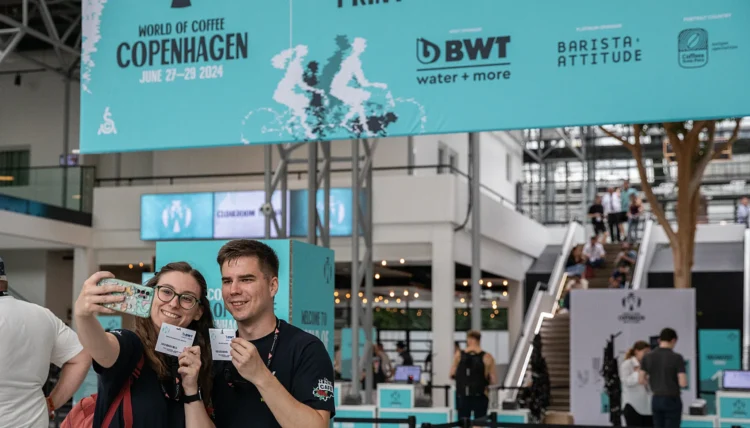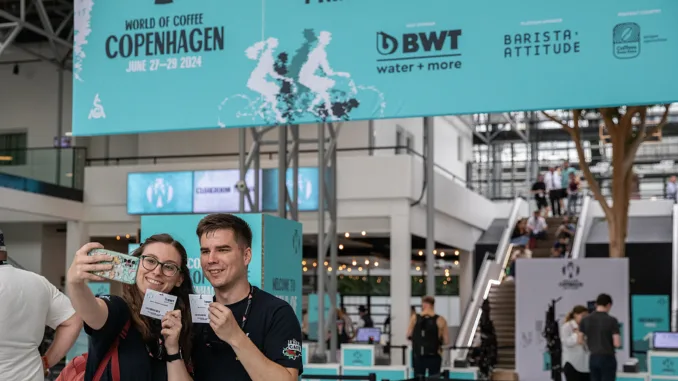
The World of Espresso Copenhagen occasion was greater than only a commerce present; it was a hub of relationships, innovation, and trendsetting.
BY ISABELLE MANI
SPECIAL TO BARISTA MAGAZINE ONLINE
Featured picture courtesy of Specialty Espresso Affiliation
The 2024 version of World of Espresso (WoC) drew a record-breaking 12,600+ attendees from 140 nations to the Bella Heart Copenhagen in Denmark, marking the most important and most various attendance in its historical past, with a 26% improve in comparison with the earlier yr.
Amidst the thrill of discovering new merchandise, social gatherings, and tasting a number of the world’s most interesting coffees, a vital facet of WoC is opening alternatives and elevating discussions about inclusivity, sustainability, and presenting instruments for progress and inclusion.
In 2024, World of Espresso inaugurated two new platforms for studying, networking, and data trade in Europe: the Retail Consumers Lounge and Inexperienced Espresso Join, aimed toward fostering data and academic trade for the trade’s holistic progress.
Within the second a part of our World of Espresso recap, which began with “5 Cool Issues We Noticed at World of Espresso Copenhagen,“ we’ll evaluation what caught our consideration concerning science, innovation, schooling, and empowerment and sustainability initiatives.
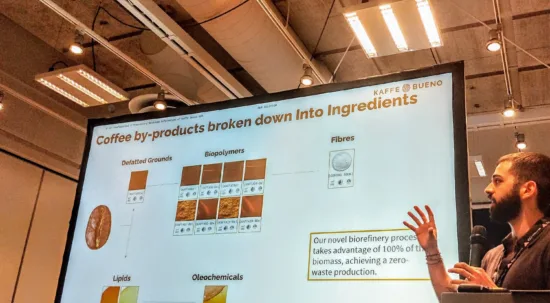
1. Upcycling and Sustainable Innovation
On the occasion, many panels and lectures centered on the revolutionary use of upcycled espresso byproducts to advertise environmental sustainability inside the espresso trade. This matter drew a number of consideration from attendees and is one which I’m massively serious about and consistently studying extra about.
As soon as thought-about waste, coffee-derived biomaterials provide quite a few advantages and viable approaches throughout varied industries. They will exchange conventional, much less sustainable substances that maintain potential in meals, prescription drugs, and cosmetics, providing pure alternate options to artificial substances. For instance, these supplies can contribute to zero waste discharge and self-sustainable fertilizer manufacturing, slicing prices for farmers.
Two standout classes have been “Round Meta-Expertise and Dialog: Tasting and Sensory Expertise of Upcycling Merchandise Fabricated from Espresso,“ and “Round Economic system: (Re)Producing Worth All through the Espresso Worth Circle.“ Each panels, supported by the Worldwide Commerce Centre’s Heart for Round Economic system in Espresso (C4CEC), have been packed, with attendees keen to interact with audio system and panelists for deeper insights.
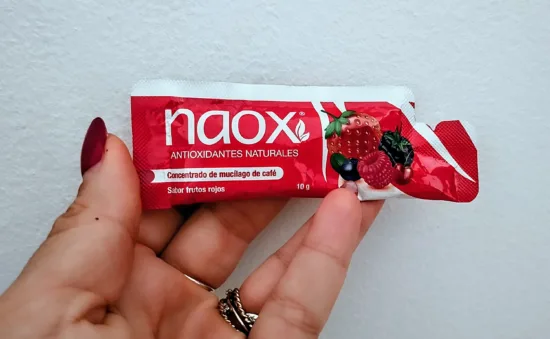
2. A New Upcycled Product
Within the first a part of this recap, I named my favourite devices, improvements, and merchandise. Nevertheless, the product that impressed me probably the most isn’t associated to barista tendencies or dwelling brewing instruments. Naox is a ready-to-drink well being beverage sachet with antioxidant properties made solely from espresso mucilage. It’s nutrient-rich and incorporates 5 occasions extra antioxidants than inexperienced tea.
Produced in Costa Rica by Coopeagri, a participant within the C4CEC, Naox was launched throughout one the aforementioned lecture “Round Economic system: (Re)Producing Worth All through the Espresso Worth Circle.“
What I like most about this product is that it highlights the dietary potential of espresso past the beans. It exemplifies how the round financial system mannequin can drive innovation by using agricultural byproducts, thus creating financial alternatives for small and medium enterprises in coffee-producing areas.
It tastes good and makes you are feeling good; I needed to disguise the additional sachet I used to be gifted as a result of all my buddies wished to strive it! Profitable instances just like the Noax well being drink showcase how upcycling can present actual options for regulating environmental influence and combating local weather change—and shout-out to Toddy’s coffee-flavored chapsticks, additionally produced with espresso byproducts, gifted of their WoC sales space.
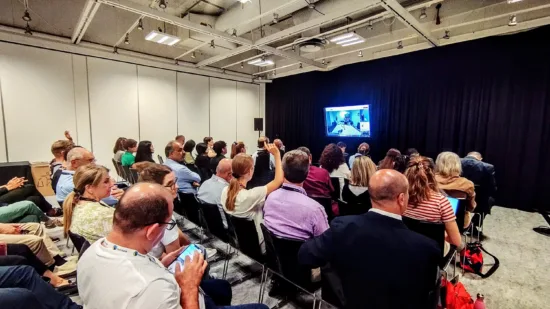

3. The EUDR Rules
The European Union Deforestation Regulation Espresso Replace Webinar (“EUDR Espresso Replace: Information, Info, and Dialogue with the EU“) was most likely the best-attended panel I’ve been to throughout World of Espresso—and the one with probably the most questions after it wrapped. There was nervous rigidity within the room. Many questions concerned the challenges in gathering required information and confusion about who’s liable for assembly the foundations to adjust to the EUDR. The regulation is slated to start out in 2025, and bans merchandise linked to deforestation except there may be proof they arrive from sustainable sources.
Considerations have been raised concerning the potential restrictions on market entry for small farmers. The primary points for attendees have been: who would bear the prices, how farmers can be educated, and the way entry to the required expertise can be offered. The data system might be accessible beginning December 2, with coaching starting in September—a decent timeline to which farmers and different stakeholders should adapt.
Most of the attendees I spoke to informed me they left the webinar with unanswered questions and unclear subsequent steps.
You may learn extra concerning the EUDR and its implications for the espresso trade right here.
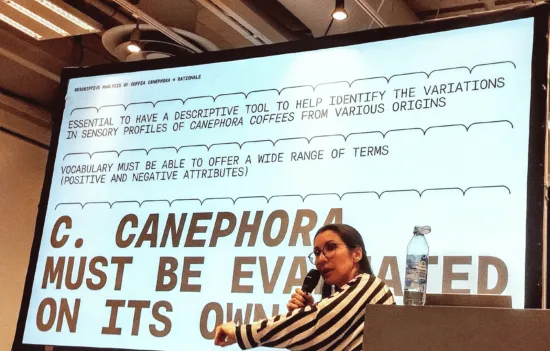

4. The Canephora Second
The panel “Constructing Markets for Specialty Canephora,“ offered by Nick Mabey from Meeting Espresso and Volcano Espresso Works, and Dr. Fabiana Carvalho, a neuroscientist Ph.D. and researcher on the College of Campinas, Brazil, was one of the vital anticipated for me. I’ve been intently following the work of a collective of scientists, producers, and roasters who’re dedicated to growing and investing in Canephora (robusta) high quality and disseminating its potential within the specialty-coffee market. “Evaluating (Canephora) on to arabica is like evaluating pink and white wine—it’s not an apples-to-apples comparability,” mentioned Fabiana.
In the course of the panel, Nick and Fabiana (who leads a scientific analysis mission on the constructing of the Canephora Taste Wheel) mentioned the significance of constructing markets for broader Canephora acceptance; certainly one of its advantages can be supplementing specialty consumption within the face of local weather change. Producing nations acknowledge the necessity and advantages, however markets should observe, defined the audio system. They advocated that high quality notion and provide chain sustainability initiatives are key to opening markets for wider consumption.
The Espresso High quality Institute stand additionally provided a Canephora tasting every single day, promoted by the organizers of Canephorum, an occasion centered on unveiling robusta’s specialty espresso potential via lectures, workshops, and cuppings. The third version will happen in Berlin on October 18-19.
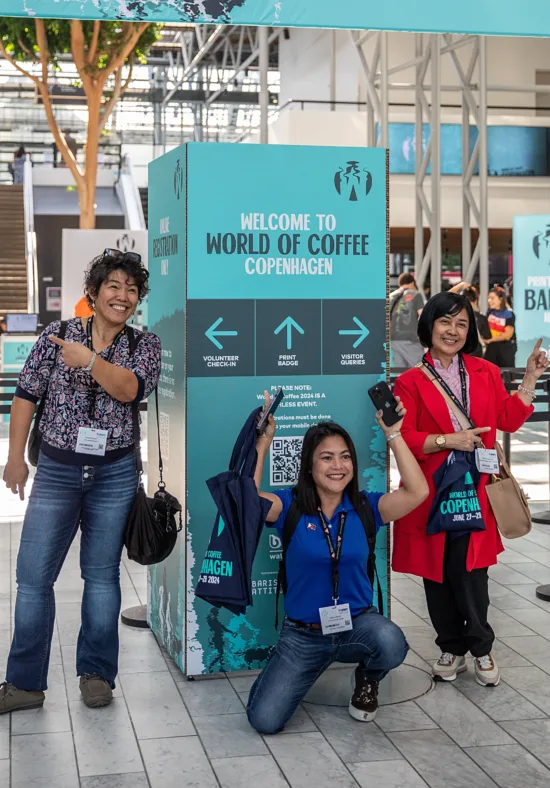

5. Ladies in Espresso: An Important Matter
The ability and significance of accelerating girls’s illustration within the espresso trade is a subject that can’t be burdened sufficient. Many feminine audio system and professionals participated in panels, lectures, workshops, and cuppings. It was inspiring to see girls worldwide working to amplify different girls’s voices, livelihoods, and recognition.
A big spotlight of the present was the formation of #IWCAGreece, with the nation formally turning into the thirty fifth member of the Worldwide Ladies’s Espresso Alliance’s international community.
Concerning the exhibitors on the Roaster Village, the Miss Moka initiative from the Italian roasters on the TrisCoffee sales space additionally caught my consideration. This initiative completely sources espresso from girls producers in Brazil in partnership with Flavia Lacerda from Arara Coffees.
Flavia defined that her firm primarily focuses on working with and selling girls producers from native populations and Afro-Brazilian roots. Moreover, the corporate sponsors the IWCA chapter within the Sul de Minas D.O. area of Brazil with certainly one of its espresso blends.
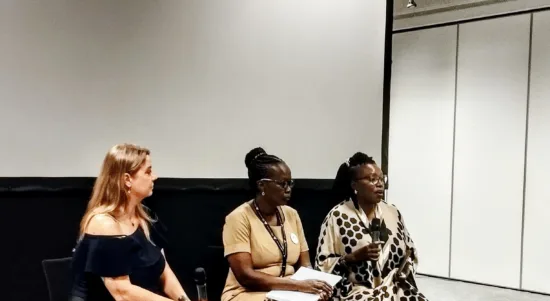

Many panels centered on girls’s positioning within the espresso manufacturing chain and showcased inclusion initiatives, however the centerpiece that exemplified this motion of unity and mutual recognition between girls was the panel “No Sustainability With out Gender Fairness: Examples from Kenya’s Espresso Sector.“ Based mostly on Dr. Erika Koss’ Ph.D. analysis on Kenya, the lecture featured Dr. Rosebella Langat of Chepsangor Hills Espresso and Gloria Wamalwa Gummerus of Sakami Espresso, each house owners and administrators of espresso estates.
They shared their experiences as farmers and leaders of sustainable companies that make use of and prepare tons of of rural girls and emphasised sustainability in specialty espresso, which is able to solely be achieved if gender fairness is realized.
“Ladies ought to band collectively … I might be very happy to surrender my spot at an occasion like WoC to one of many girls engaged on my property so she will be able to have a voice and perceive the significance of her work,“ mentioned Dr. Rosebella Langat.
ABOUT THE AUTHOR
Isabelle Mani (she/her) is a author, journalist, and communicator specializing within the worldwide espresso trade. Since 2017, she has centered on writing articles and options for varied worldwide espresso information shops. Isabelle has traveled to coffee-producing nations comparable to Colombia, Kenya, Rwanda, China, and Brazil to review and analysis espresso. She holds coaching certifications from the Specialty Espresso Affiliation (SCA) and the Espresso High quality Institute (Arabica Q Grading).
Subscribe and Extra!
Out now: It’s the June + July 2024 problem of Barista Journal! Learn it free of charge with our digital version. And for greater than three years’ price of points, go to our digital version archives right here.
You may order a tough copy of the journal via our on-line retailer right here, or begin a subscription for one yr or two.
